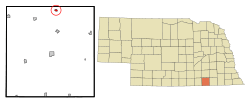Bruning, Nebraska facts for kids
Quick facts for kids
Bruning, Nebraska
|
|
|---|---|
|
Village
|
|

Downtown Bruning: north side of Main Street, July 2010
|
|

Location of Bruning, Nebraska
|
|
| Country | United States |
| State | Nebraska |
| County | Thayer |
| Area | |
| • Total | 0.27 sq mi (0.70 km2) |
| • Land | 0.27 sq mi (0.70 km2) |
| • Water | 0.00 sq mi (0.00 km2) |
| Elevation | 1,588 ft (484 m) |
| Population
(2020)
|
|
| • Total | 285 |
| • Estimate
(2021)
|
278 |
| • Density | 1,056/sq mi (407/km2) |
| Time zone | UTC-6 (Central (CST)) |
| • Summer (DST) | UTC-5 (CDT) |
| ZIP code |
68322
|
| Area code(s) | 402 |
| FIPS code | 31-06820 |
| GNIS feature ID | 2397476 |
Bruning is a small village located in Thayer County, Nebraska, in the United States. In 2020, about 285 people lived there. It's a quiet place with a rich history.
Contents
History of Bruning
Bruning was started in 1887. It grew up around the new railroad line. The village was named after Frank Bruning.
During World War II, the U.S. Army Air Forces had an airfield nearby. This was called Bruning Army Airfield. It was an important place for military planes.
Bruning is also famous for a special flight. In October 1960, a person named Ed Yost took off from here. He was an inventor and pilot. He made the first free flight in a modern hot air balloon. This balloon used propane fuel. It was a big step in ballooning history!
Geography of Bruning
Bruning is a small village. It covers an area of about 0.70 square kilometers (0.27 square miles). All of this area is land, with no large bodies of water.
Population of Bruning
Bruning has seen its population change over the years. Here's how many people have lived there during different census counts:
| Historical population | |||
|---|---|---|---|
| Census | Pop. | %± | |
| 1900 | 255 | — | |
| 1910 | 353 | 38.4% | |
| 1920 | 326 | −7.6% | |
| 1930 | 316 | −3.1% | |
| 1940 | 374 | 18.4% | |
| 1950 | 246 | −34.2% | |
| 1960 | 289 | 17.5% | |
| 1970 | 315 | 9.0% | |
| 1980 | 330 | 4.8% | |
| 1990 | 332 | 0.6% | |
| 2000 | 300 | −9.6% | |
| 2010 | 279 | −7.0% | |
| 2020 | 281 | 0.7% | |
| 2021 (est.) | 278 | −0.4% | |
| U.S. Decennial Census | |||
What the 2010 Census Showed
In 2010, there were 279 people living in Bruning. They lived in 135 homes. Most people in the village were White.
About 19% of the people were under 18 years old. Around 27% were 65 years or older. The average age in the village was about 48 years old. The population was almost evenly split between males and females. About 49.8% were male and 50.2% were female.
See also
 In Spanish: Bruning (Nebraska) para niños
In Spanish: Bruning (Nebraska) para niños

